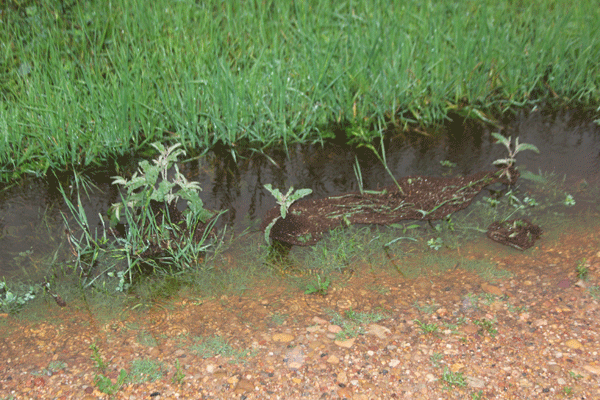Guess, in the photo above, what the dark brown mat is on the water in the ditch after a two inch rain. In case you don’t know, it’s a floating mat of fire ants.
The most common ant on the farm is the Imported Fire Ant (Solenopsis invicta). This species is not native to North America but is established throughout the US Gulf Coast. It reached our area in the mid-1960s; I vividly remember my first encounter with them. I stepped on a mound and the worker ants exploded out covering my foot and stinging repeatedly.
Today, I’ve learned to appreciate this ant despite its readiness to sting. Once this species became established in our area, fleas, ticks, and house flies almost disappeared.
Prior to fire ants’ arrival every outdoor trip required a post-excursion search for newly attached ticks. The worst were the “seed ticks,” tiny newly hatched ticks. They lay in wait in the hundreds if not thousands on downed tree trunks, rocks, bushes, weeds and the like. If you tarried too long in one place you ended up with dozens of them. Even moving rapidly didn’t prevent the ticks from transferring from their perch to your leg. Adult ticks that managed to hitch a ride quickly migrated to the first tight spot in your clothing to impale you with their beak. Given just a few hours, a tick could swell up to almost grape size with your blood. Pulling them off left their beak in your skin causing a very itchy reaction.
At the same time, battling fleas on our dogs and cats was a constant fight. Once flea collars became available, my Grandmother’s Chihuahuas always sported new ones in an attempt to keep them flea free, usually to no avail.
Flies were ubiquitous on the farm due to all the livestock, cattle, pigs, horses, chickens, etc. During the summer the most common order from adults to us kids was, “Close the damn door! You’re letting flies in!” Every room had a flyswatter. Swarms of gnats were always present outdoors, landing on any food or in drinks. Today all of these are rare thanks to fire ants.
Let’s return to the mat of ants. The photo below is a close up of the mat. When fire ant nests are flooded the ants form a waterproof, floating raft made up of their own bodies. When inner-tubing on flooded waterways where fire ants are common, you learn to avoid the floating rafts. If one touches your tube or worse, body, the ants swarm on to the “dry land” and become annoyed when you attempt to brush them off.

All in all, I prefer the fire ants to the other pests. The occasional sting is worth the lack of fleas, ticks, and flies.


Leave a Reply